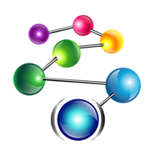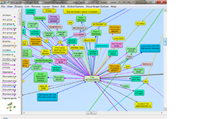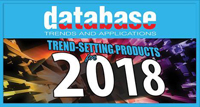Franz periodically distributes newsletters to its Semantic Technologies, and Common Lisp based Enterprise Development Tools mailing lists, providing information on related upcoming events and new software product developments. The latest newsletter is displayed below. Previous issues are listed in the Newsletter Archive.
AllegroGraph News
March, 2018
In this issue
- Webcast - Navigating Time and Probability in Knowledge Graphs
- Webcast - A Jupyter Notebook for Learning AllegroGraph (Bonus n-Dimensional GeoSpatial)
- InfoWorld article - The marvels of an event-based schema
- AllegroGraph 6.4.1 - Now Available
- Gruff v7.2.1 - Now Available
- IEEE Publication - Transmuting Information to Knowledge with an Enterprise Knowledge Graph
- Enterprise Data World - Taking Graphs to the Next Level with Artificial Intelligence and Machine Learning - April 22-27, 2018
- Franz Inc. - Named to Trend-Setting Products in Data and Information Management for 2018 by Database Trends and Applications
- Analytics Week article - The Secret to Business Users Understanding Big Data: Enterprise Taxonomies
- InfoWorld article - Harmonizing big data with an enterprise knowledge graph
- Dataconomy article - Triple Attributes: A New Way to Protect the Most Sensitive Information
- Follow us on Google Plus, Twitter, LinkedIn, and YouTube
- Recent Articles
Webcast - Navigating Time and Probability in Knowledge Graphs

Thursday, March 22 at 11AM Pacific
The market for knowledge graphs is rapidly developing and evolving to solve widely acknowledged deficiencies with data warehouse approaches. Graph databases are providing the foundation for these knowledge graphs and in our enterprise customer base we see two approaches forming: static knowledge graphs and dynamic event driven knowledge graphs.
Static knowledge graphs focus mostly on metadata about entities and the relationships between these entities but they don’t capture ongoing business processes. DBPedia, Geonames and Census or Pubmed are great examples of static knowledge. Dynamic knowledge graphs are used in the enterprise to facilitate internal processes, facilitate the improvement of products or services or gather dynamic knowledge about customers.
Dr. Aasman recently authored an IEEE article describing this evolution of knowledge graphs in the Enterprise and during this presentation we will describe two critical success factors for dynamic knowledge graphs, a uniform way to model, query and interactively navigate time and the power of incorporating probabilities into the graph. The presentation will cover three use cases and live demos showing the confluence of knowledge via machine learning, visual querying, distributed graph databases, and big data not only displays links between objects, but also quantifies the probability of their occurrence.
To register for this webinar, see here
The IEEE Paper Link
Webcast - A Jupyter Notebook for Learning AllegroGraph (Bonus n-Dimensional GeoSpatial)

The Jupyter Notebook is an open-source web application that allows you to create and share documents that contain live code, equations, visualizations and narrative text.
Join us to learn more about the examples available with AllegroGraph's new Python tutorial using Jupyter Notebook for interactive learning.
To register for this webinar, see here
InfoWorld article - The marvels of an event-based schema

When working with various data types at the speed of big data, this method is ideal for integrating and aggregating assorted information for the holistic value it provides.
The issue of schema—and what is frequently perceived as its inherent difficulties—is becoming more important every day. Organizations are increasingly encountering decentralized computing environments typified by semi-structured or unstructured external data of varying formats, often requiring integration with internal, structured data for immediate business value...
To read the full article, see here
AllegroGraph 6.4.1 - Now Available

New Features Include:
|
AllegroGraph Multi-master Replication is a real-time transactionally consistent data replication solution. It allows businesses to move and synchronize their semantic data across the enterprise. This facilitates real-time reporting, load balancing, and disaster recovery. |
For additional information, see here
Gruff v7.2.1 - Now Available

New Features Include:
Gruff’s new 'Time Machine' feature provides users an important capability to explore temporal connections in your data. This capability lets you see how relationships are created over time and are you are able to replay the evolving graph for new temporal based insights."
Gruff produces dynamic data visualizations that organize connections between data in views that are driven by the user. This visual flexibility can instantly unveil new discoveries and knowledge that turn complex data into actionable business insights. Gruff was developed by Franz to address Graph Search in large data sets and empower users to intelligently explore graphs in multiple views including:
- Graphical View with new “Time Machine” feature - See the shape and density of graph data evolve over time
- Tabular view - Understand objects as a whole
- Outline view - Explore the often hierarchical nature of graphs
- Query view - Write Prolog or SPARQL queries
- Graphical Query Builder - Create queries visually via drag and drop
For additional information, see the Gruff Documentation
IEEE Publication - Transmuting Information to Knowledge with an Enterprise Knowledge Graph

The enterprise knowledge graph for entity 360-views has emerged as one of the most useful graph database technology applications when buttressed by W3C standard semantic technology, modern artificial intelligence, and visual discovery tools. Read this IEEE publication by Dr. Jans Aasman to learn more about Knowledge Graphs.
For additional information, see here
Enterprise Data World - Taking Graphs to the Next Level with Artificial Intelligence and Machine Learning - April 22-27, 2018

The 22nd Annual Enterprise Data World (EDW) Conference hosted by DATAVERSITY® is recognized as the most comprehensive educational conference on data management in the world. Join hundreds of data professionals from around the globe to attend this unique conference. Your transformation to data-driven business starts here!
Franz CEO Jans Aasman will be presenting "Taking Graphs to the Next Level with Artificial Intelligence and Machine Learning".
Graphs and Knowledge Management have gained significant visibility with the rebirth of artificial intelligence and emergence of cognitive computing. By combining artificial intelligence, big data, graph databases, and dynamic visualizations, we will discuss deploying Graph based AI applications as a means to help predict future events across numerous types of industries.
Knowledge creation via AI and Graphs stems from the capability to combine the probability space (i.e. statistical inference on a user’s data) with a knowledge base of comprehensive industry terminology systems. AI using Graphs are remarkable not just because of the possibilities they engender, but also because of their practicality. The confluence of knowledge via machine learning, visual querying, graph databases, and big data not only displays links between objects, but also quantifies the probability of their occurrence. We believe this approach will be transformative across numerous business verticals.
During the presentation we will describe the Graph based AI concepts that also incorporate Hadoop, along with analytics via R, SPARK ML and other AI techniques for practical Enterprise predictive analytics use cases.
For additional information, see here
Franz Inc. - Named to Trend-Setting Products in Data and Information Management for 2018 by Database Trends and Applications

Today, innovative approaches, such as Hadoop, Spark, NoSQL, and NewSQL, are being used in addition to more established technologies, such as the mainframe, and relational and MultiValue database systems. In addition, artificial intelligence and machine learning capabilities are some of the newer approaches being introduced in products. To help bring these resources to light, each year, Database Trends and Applications magazine looks for offerings that promise to help organizations derive greater benefit from their data, make better decisions, work more efficiently, achieve greater security, and address emerging challenges. In total, this list of forward-looking products helps illuminate the path on which the data management market is headed.
For additional information, see:
- http://www.dbta.com/Editorial/Trends-and-Applications/Trend-Setting-Products-in-Data-and-Information-Management-for-2018-121846.aspx
- http://www.dbta.com/Editorial/Actions/Product-Spotlight-Franz-Inc-121893.aspx
Analytics Week article - The Secret to Business Users Understanding Big Data: Enterprise Taxonomies

The key to understanding big data doesn’t lie with some existent, or even forthcoming, application of Artificial Intelligence—although AI can certainly abet the process. Nor does it expressly relate to any facet of data science, blockchain, or decentralized computing application such as the Industrial Internet. Instead, the basis for modeling, integrating, governing, and even querying many of these manifestations of the data ecosystem lies with something much simpler: words.
Classifications of words and their hierarchies, taxonomies, are the rudiment to understanding big data’s meaning in terms business users comprehend. When such terminology systems span the enterprise, they create opportunities for the business to capitalize on big data’s underlying meaning, regardless of its form or the techniques used to access it...
To read the full article, see here
InfoWorld article - Harmonizing big data with an enterprise knowledge graph

In addition to streamlining how users retrieve diverse data via automation capabilities, a knowledge graph standardizes those data according to relevant business terms and models.
One of the most significant results of the big data era is the broadening diversity of data types required to solidify data as an enterprise asset. The maturation of technologies addressing scale and speed has done little to decrease the difficulties associated with complexity, schema transformation and integration of data necessary for informed action...
To read the full article, see here
Dataconomy article - Triple Attributes: A New Way to Protect the Most Sensitive Information

Semantic Graph Databases are now common in many industries, including life sciences, healthcare, the financial industry and in government and intelligence agencies. Graphs are particularly valuable in these sectors because of the complex nature of the data and need for powerful, yet flexible data analytics.
Attributes, user attributes and static filters are a new mechanism for graph databases to protect sensitive information. This combination provides the right amount of power and flexibility to address high-security use cases, such as: HIPAA access controls, privacy rules for banks, security models for policing, intelligence and the government. In addition, this set of methods is far easier to use, provides more expressiveness than security methods in relational databases and doesn’t suffer from performance degradations.
To read the full article, see here
Follow us on Google Plus, Twitter, LinkedIn, and YouTube
Recent Articles about Franz

|
|

|
|
Please add me to your newsletter mailing list. We
promise never to sell or divulge your email address to anyone. We will
only occasionally send you information relevant to our products (about
once a month).
Click here to unsubscribe. Send the email message that opens.
| Copyright © Franz Inc., All Rights Reserved | Privacy Statement | 
|

|

|

|

|












